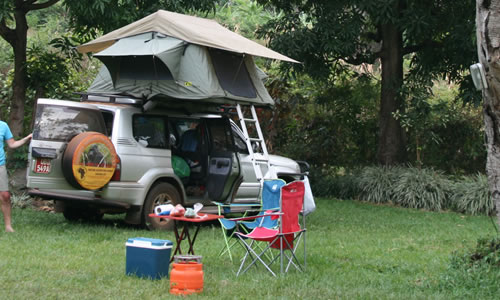Many travelers prefer the self-drive tour option as it allows for more freedom and independence. Explore the country at hand at your own whim and pace, like a true traveler, behind the wheel of your rental vehicle.

On our 18-day gorilla and wildlife safari, we decided to rent a 4×4 rooftop tent land cruiser from 4×4 Car Hire Uganda for a road trip to Rwanda which was once regarded to be among the most fractious of African countries, Rwanda suffered multiple outbreaks of civil war and ethnic violence during its first 30 years as an independent state, culminating in the Genocide against the Tutsi that claimed the lives of one-eighth of its population in 1994. The 4×4 jeep price range from 85$ US – 90$ US inclusive of the camping gears and the 45 Liters electric fridge.
When I first visited the country in 2001, memories of the genocide were still raw, but the country had already embarked on a long and arduous road to normalization from which it has barely deviated in the subsequent two decades.
Few back then would have predicted that Rwanda would one day rank among Africa’s most compelling wildlife-viewing destinations. Yet that is exactly what it is today. Indeed, this is the only country in Africa to host wild populations of all the following iconic creatures: gorilla, chimpanzee, lion, leopard, buffalo, elephant, black rhino and white rhino.
Rwanda’s number one attraction is undoubtedly the opportunity to track mountain gorillas on the forest- and bamboo-swathed slopes of Volcanoes National Park, the very same place where the late Dian Fossey studied gorilla behavior for almost 20 years, and the movie Gorillas in the Mist was shot in 1988.
Gorillas aside, Rwanda offers several other wonderful primate-viewing opportunities. Mischievous 100-strong troops of the endangered golden monkey inhabit Volcanoes National Park, where they are mainly associated with bamboo forest.
Primate diversity is highest in the immense Nyungwe National Park, with its habituated chimps and plethora of monkeys and rare birds. Chimps, monkeys and many forest birds are also resident in the recently gazetted Gishwati – Mukura National Park.
Rwanda once slacked as a conventional safari destination, but that has changed dramatically following a recent program of re-introductions that have upgraded Akagera National Park to a fully-fledged Big Five Savannah reserve.
Other attractions include Lake Kivu, a vast inland sea hemmed by the sheer slopes of the western Rift Valley, the hiker- and cyclist-friendly Congo Nile Trail through the Kivu hinterland, and the endless succession of steep cultivated mountains that have justifiably earned Rwanda the sobriquet ‘Land of a Thousand Hills’.
During the road trip in Rwanda, I visited national parks below
Akagera National Park
Akagera is the only protected area offering traditional Big Five safaris in Rwanda. It boasts good wildlife opportunities, although not on quite the same scale as other iconic East African parks. Unlike the densely forested protected areas elsewhere in the country, Akagera is a typical Savannah park dominated by sprawling grasslands and broken woodland. While on a game drive you will be able spot elephant, buffalo, giraffe, tsessebe, impala and Defassa water buck, while large populations of hippo and the elusive sitatungas – a rare aquatic antelope – thrive in the well-watered eastern sector of the reserve.
Nyungwe Forest National Park
Nyungwe only became a national park in 2004, established to protect its lush rain forest that is home to a staggering 13 species of primates. These include huge troops of Colobus monkeys that look like aging hippies with long white beards, plus grey-cheeked mangabey and chimpanzees. Chimps are also the main attraction in nearby Cyamudongo Forest and we were lucky enough to see several swinging in the trees and a young mum giving her baby a piggyback.
It really is like walking through a fairy tale here, with towering mahoganies and ebony trees, and its home to east Africa’s highest canopy walk where you teeter on a gently swaying bridge some 70m above the forest. Luckily, I don’t suffer from vertigo, but people who struggle with heights might find this unnerving!
This is just one part of 130km of walking trails and you’ll have to take a guide, but they serve to enhance the whole experience and help to bring the secret life of the forest alive.
Volcanoes National Park
I’m fortunate through my work to have tracked mountain gorillas four times and it never disappoints. It is the ultimate wildlife encounter. In Volcanoes National Park it’s a very smooth and well-managed operation, with strict rules to ensure gorillas aren’t adversely affected by visitors.
These include, but aren’t limited to keeping a distance of 7m from the gorillas (although gorillas don’t know this), never tracking gorillas if you have a respiratory infection or diarrhea, and never touching the animals.
Volcanoes National Park is often considered an ‘easier’ trek than those in Uganda’s Bwindi Impenetrable National Park, the other main center for tracking mountain gorillas. However, if you’re allocated to Susa B group, this may not be the case – their home territory lies high up Mount Karisimbi and it’s an exhausting hike to reach them.
Aside from gorilla tracking, there is lots more to do in Volcanoes National Park. Most popular is spending an hour with a troop of habituated golden monkeys. If you haven’t spent much time at altitude, this is a great one to acclimatize before your gorilla trek.
The hike to Dian Fossey’s Research Station is quite easy and especially worthwhile if you’re familiar with the famous primatologist’s heartbreaking story. As a keen hiker, I also climbed Bisoke Volcano and the views of the Crater Lake are more than worth the strenuous ascent.
